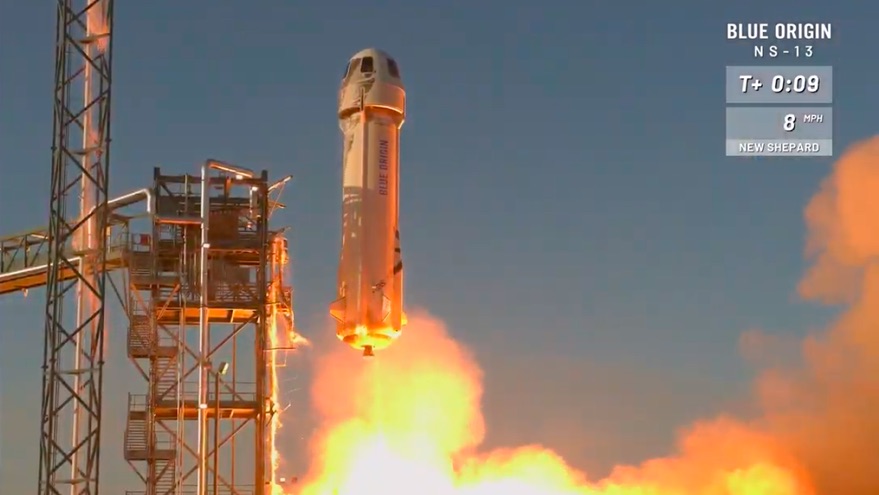WASHINGTON — Blue Origin’s New Shepard suborbital vehicle made its first flight in 10 months Oct. 13, carrying a dozen payloads for NASA and other customers to the edge of space and back.
The vehicle lifted off from the company’s West Texas test site on a mission designated NS-13 at 9:36 a.m. Eastern. The vehicle flew as expected, reaching a peak altitude of about 105 kilometers. The vehicle’s booster made a powered landing seven and a half minutes after liftoff, followed by the crew capsule’s landing by parachute nearly three minutes later.
The flight was the first for New Shepard since the NS-12 mission in December 2019. A launch attempt Sept. 24 was first delayed by cloudy conditions and later scrubbed because of what the company termed a “potential issue with the power supply” for the experiments on board the vehicle. An unspecified technical issue the next day prompted an extended delay.
The NS-13 mission carried a dozen science and technology demonstration payloads, including NASA’s Deorbit, Descent, and Landing Sensor Demonstration. That experiment, funded by NASA’s Tipping Point technology development program, is part of an agency project called Safe and Precise Landing – Integrated Capabilities Evolution (SPLICE) to develop systems that could be used by future lunar landers for precision landings in terrain not accessible with existing systems.
“Today’s flight was inspiring. Using New Shepard to simulate landing on the moon is an exciting precursor to what the Artemis program will bring to America,” Bob Smith, chief executive of Blue Origin, said in a statement after the flight. Blue Origin is one of three companies with NASA Human Landing System awards to study lunar landers for the Artemis program.
The experiment is the first to fly on the exterior of New Shepard, mounted near the ring fins at the top of the booster module. “We’ve been seeing more demand for putting payloads on the outside of the rocket,” Erika Wagner, payload sales director at Blue Origin, during a webinar about the company’s suborbital research opportunities organized by the Canadian Space Agency in August.
That included, she said, payloads like the NASA experiment to test precision landing. “Coming down from 100 kilometers towards the Earth is like coming from low lunar orbit down to the lunar surface.”
The other experiments on the flight were in the crew capsule, such as a test of a plant growth system for use in microgravity developed by Space Lab Technologies and the University of Colorado at Boulder, and an experiment from the Southwest Research Institute to test sampling regolith from the surface of asteroids. The capsule also carried thousands of student postcards from Blue Origin’s nonprofit education arm, Club for the Future.
Blue Origin intends to ultimately fly people on New Shepard, but has not set a timetable for doing so. Early last year the company’s founder, Jeff Bezos, suggested crewed flights could begin later that year, but Blue Origin executives later said they slowed down work on the program. In February, company officials, speaking on background, anticipated needing three to four more uncrewed missions before they would be ready to start flying people.
The company said little about their human spaceflight plans during a webcast of the flight, beyond discussing how the interior of the crew capsule is intended to accommodate six people and rehearsals of how people will board the capsule and go through pre-flight preparations. Company representatives said during the webcast they expected to need “just a couple more flights before we start to put humans on board.”
At the Canadian webinar, Wagner said Blue Origin would continue to fly payload-only missions. The company was studying new opportunities, such as “partial-g” flights where reaction control thrusters would spin up the capsule after separation to simulate lunar gravity conditions. “We’ve been talking to investigators about a wide range of experiments” that could be flown on such flights, she said, with the first such flight planned for “2022-ish.”
She declined to give a schedule at the event of future New Shepard payload flights, but noted the company was flying two to three missions a year with payloads, suggesting that rate would continue. “If there is more demand, we’ll fly more.”
